DETERMINE IF A FUNCTION IS LINEAR QUADRATIC OR CONSTANT
The function can be classified based on the degree of the polynomial.
Degree of the polynomial is the highest exponent of the polynomial.
|
Degree 0 1 2 |
Name of the polynomial Constant Linear Quadratic |
If the given polynomial is in factored form, use distributive property then do the possible simplification.
Then we can find out the degree and classify it.
Determine whether each function is linear or quadratic. Identify the quadratic, linear, and constant terms.
Problem 1 :
y = (x – 2)(x + 4)
Solution :
It is in factored form.
y = x2 + 4x - 2x - 8
y = x2 + 2x - 8
The degree of the polynomial is 2. So, it is quadratic.
Problem 2 :
y = 3x(x + 5)
Solution :
y = 3x(x + 5)
Distributing 3x, we get
y = 3x2 + 15x
Degree of the polynomial is 2. So, it is quadratic polynomial.
Problem 3 :
y = 5x(x – 5) –5x2
Solution :
y = 5x(x – 5) –5x2
y = 5x2 – 5x –5x2
By combining the like terms, we get
y = – 5x
Degree of this polynomial is 1. So, it is a linear.
Problem 4 :
f(x) = 7(x – 2) + 5(3x)
Solution :
f(x) = 7(x – 2) + 5(3x)
f(x) = 7x - 14 + 15x
By combining the like terms
f(x) = 22x - 14
The degree of the polynomial is 1. So it is linear.
Problem 5 :
f(x) = 3x2 – (4x – 8)
Solution :
f(x) = 3x2 – (4x – 8)
f(x) = 3x2 – 4x + 8
Degree of the f(x) is 2. So, it is quadratic polynomial.
Problem 6 :
y = 3x(x – 1) – (3x + 7)
Solution :
y = 3x(x – 1) – (3x + 7)
y = 3x2 - 3x - 3x - 7
By combining the like terms, we get
y = 3x2 - 6x - 7
The degree of the polynomial is 2. So, it is quadratic.
Problem 7 :
y = 3x2 – 12
Solution :
The degree of the polynomial is 2. So, it is quadratic.
Problem 8 :
f(x) = (2x – 3)(x + 2)
Solution :
The degree of the polynomial is 2. So, it is quadratic.
Identify Linear, Quadratic, and Exponential functions from Tables
You can use patterns between consecutive data pairs to determine which type of function models the data. The differences of consecutive y-values are called first differences. The differences of consecutive first differences are called second differences.
• Linear Function The first differences are constant.
• Exponential Function Consecutive y-values have a common ratio.
• Quadratic Function The second differences are constant. In all cases, the differences of consecutive x-values need to be constant.
Tell whether each table of values represents a linear, an exponential, or a quadratic function.
Problem 9 :

Solution :
|
Relationship between x-values -3 + 1 ==> -2 -2 + 1 ==> -1 -1 + 1 ==> 0 0 + 1 ==> 1 |
Relationship between y-values 11 - 3 ==> 8 8 - 3 ==> 5 5 - 3 ==> 2 2 - 3 ==> -1 |
The first differences are constant, then the given table must be in linear function.
Problem 10 :

Solution :
|
Relationship between x-values -2 + 1 ==> -1 -1 + 1 ==> 0 0 + 1 ==> 1 1 + 1 ==> 2 |
Relationship between y-values 1 x 2 ==> 2 2 x 2 ==> 4 4 x 2 ==> 8 8 x 2 ==> 16 |
Consecutive y-values have a common ratio. So, the table represents an exponential function.
Problem 11 :

Solution :
Relationship between x-values :
-2 + 1 ==> -1
-1 + 1 ==> 0
0 + 1 ==> 1
1 + 1 ==> 2
Relationship between y-values :
|
First difference : -1 - 1 ==> -2 -2 + 1 ==> -1 -1 + 3 ==> 2 2 + 5 ==> 7 |
Second difference : -1 - 1 ==> -2 1 - 3 ==> -2 3 - 5 ==> -2 |
The second differences are constant. So, the table represents a quadratic function.
Tell whether the points appear to represent a linear, an exponential, or a quadratic function.
Problem 12 :
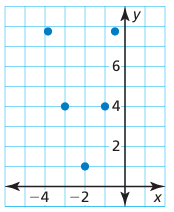
Solution :
By connecting the points, we will get the graph of parabola. So, it must be a quadratic function.
Problem 13 :
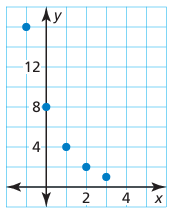
Solution :
By connecting the points, we will get the graph of exponential decreasing. So, it must be a exponential function.
\Problem 14 :
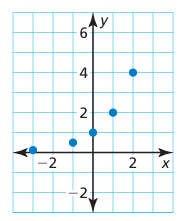
Solution :
By connecting the points, we will get the graph of exponential increasing. So, it must be a exponential function.
Problem 15 :
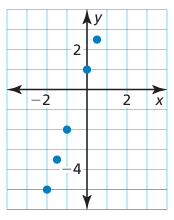
Solution :
By connecting the points, we will get the graph of straight line. So, it must be a linear function.
Problem 16 :
Match each graph with its function. Explain your reasoning.
a) y = 2x2 − 4 b) y = 2x − 1 c) y = 2x − 1 d) y = −2x2 + 4
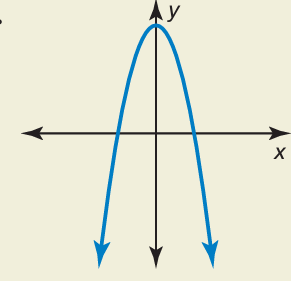 |
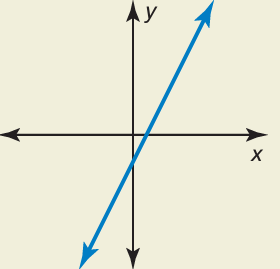 |
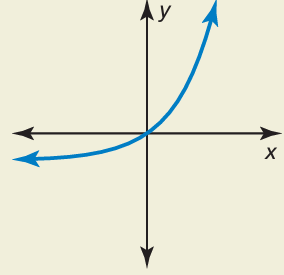 |
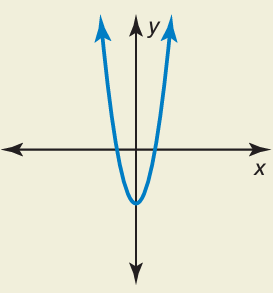 |
Solution :
 |
The graph shows a parabola which opens down, then the leading coefficient will have negative sign. So option d) y = −2x2 + 4 is correct. |
 |
The graph shows a straight line. So, option c) y = 2x − 1 is correct. |
 |
The graph shows exponential function. So, option b) y = 2x − 1 is correct. |
 |
The graph shows a parabola which opens up, then the leading coefficient will have positive sign. So option a) y = 2x2 − 4 is correct. |
Recent Articles
-
Finding Range of Values Inequality Problems
May 21, 24 08:51 PM
Finding Range of Values Inequality Problems -
Solving Two Step Inequality Word Problems
May 21, 24 08:51 AM
Solving Two Step Inequality Word Problems -
Exponential Function Context and Data Modeling
May 20, 24 10:45 PM
Exponential Function Context and Data Modeling